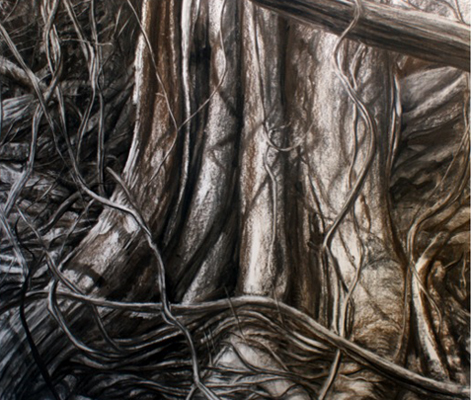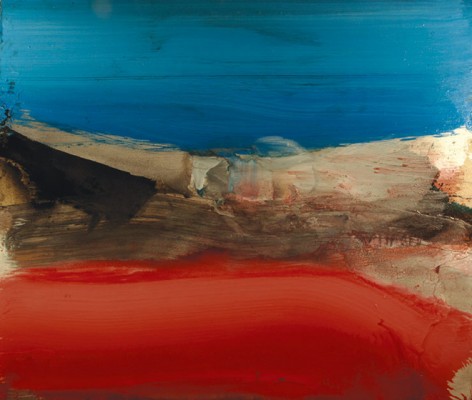Artist on Artist: Ron Bechet on Ed Clark

Ron Bechet, Sanctified Earth, 2011. Charcoal on paper. Courtesy the artist.
Some years ago my neighbor Eric Hutcherson and his late father Charles—both great artists in their own right—told me about a painter who lived in New York. They said he was born in New Orleans and moved away when he was young. They told me his name was Edward Clark. He was a relative of theirs (Ed’s mother’s family name was Hutcherson). I looked for his work at the library (I’m giving away my age) and couldn’t find much—only some articles and images in the African-American art journal founded by Samella Louis. I was impressed with what little I saw and read. Here was a man born in New Orleans in 1926 who was making his way as an artist. What was more amazing to me was that he was black and, although he had been very successful elsewhere, New Orleans had not paid much attention to him. I later learned that he—along with Norman Lewis—was part of the Cedar Tavern crowd of Abstract Expressionists in New York in the late ’50s. Clark had a solo show at the legendary Brata Gallery co-op on 10th Street in 1958.
In 1996, the New Orleans Museum of Art brought to town an exhibition called “Explorations in the City of Lights: African-American Artists in Paris, 1945-1965” that had been produced by the Studio Museum in Harlem. Clark was part of the exhibition and—along with artists Herbert Gentry and Barbara Chase-Riboud—he traveled to New Orleans with the show. While here, Clark came out to visit John T. Scott and me at the studio space we shared in New Orleans East. On the long ride to the studio he talked about meeting Josef Albers when he was cleaning the gallery where Albers was having an exhibition—a different use of his trademark broom.
In 1956—the year I was born—Clark began to use the push broom to paint. I can’t help but think what it must have been like for Clark in the ’50s and ’60s, painting abstraction and being black. “Difficult” is such an easy word to use, but Clark’s experiences in an American art world that largely excluded him and other African Americans working in abstraction can hardly be described another way. Although Clark is very positive about the camaraderie of his artist peers at the time, my mind returns to the famous photograph of Jackson Pollock and other Abstract Expressionists in which fellow black painter Norman Lewis has literally been cut out of the picture. Clark has said that it wasn’t until he lived in France that he truly understood the consequences of race and racism on creativity in America. Of his time in Europe, he revealingly joked: “Over there, rejection had nothing to do with being black. I was viewed as an American. It wasn’t about race. It was only one culture saying that another culture wasn’t up to snuff.”
I recently went to Baton Rouge to see the exhibition “Beyond Black,” which includes Clark, John T. Scott, and Eugene Martin. When I looked at Clark’s work, I recalled that first time I met him at the studio. Our conversations came back in front of the large paintings with bold direct marks made in a very deliberate way—much like his personality. In one of the only books about his work, Edward Clark: For the Sake of the Search, Clark said in an interview with Quincy Troupe: “The real truth is the stroke. For me it is the large, bold strokes that do not refer distinctly to nature. The paint is the subject. The motions of the strokes give the work life.” He went on to say, “It’s like cutting through something really fast: that’s what the strait stroke gives you, speed.” You can see this in a painting like The Crescent, 2006. The heavy impasto linear marks of intense red and blue are separated by a neutral brown shape moving slower across the canvas, compressed by the bold blue and red into a crescent. Other paintings on view are older, including part of an oval series of works that Clark started in 1968 while in Vétheuil, France with his friend, the painter Joan Mitchell. When experiencing Clark’s work, one always feels the energy of the mark-making and the emotional experience of the color.
In the presence of Clark’s work and that of the two other African-American artists included in the exhibition, I was confused by the title “Beyond Black.” I’m still not sure whether the curator means to imply that these artists have transcended race through the making of their art. If so, I think that these artists might say that their work is what it is because of who they are as African Americans and not despite it.

Ed Clark, The Crescent, 2006. Acrylic on canvas. Courtesy the artist and G. R. N'Namdi Gallery, Detroit.
Editor's Note
“Beyond Black: Ed Clark, Eugene Martin and John T. Scott” on view through May 8, 2011 at the LSU Museum of Art in the Shaw Center for the Arts in Baton Rouge.



